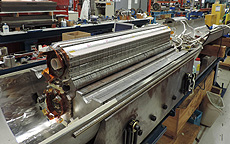New magnet at Fermilab achieves high-field milestone
 |
| This magnet recently achieved an important milestone, reaching its design field of 11.5 Tesla. It is the first successful niobium-3-tin, twin-aperture accelerator magnet in the world. Photo: Sean Johnson, TD |
Last month, a new superconducting magnet developed and fabricated at Fermilab reached its design field of 11.5 Tesla at a temperature nearly as cold as outer space. It is the first successful twin-aperture accelerator magnet made of niobium-3-tin in the world.
The advancements in niobium-3-tin, or Nb3Sn, magnet technology and the ongoing U.S. collaboration with CERN on the development of these and other Nb3Sn magnets are enabling the use of this innovative technology for future upgrades of the Large Hadron Collider (LHC). They may also provide the cornerstone for future circular machines of interest to the worldwide high-energy physics community. Because of the exceptional challenges — Nb3Sn is brittle and requires high-temperature processing — this important milestone was achieved at Fermilab after decades of worldwide R&D efforts both in the Nb3Sn conductor itself and in associated magnet technologies.
Superconducting magnets are at the heart of most particle accelerators for fundamental science as well as other scientific and technological applications. Superconductivity is also being explored for use in biosensors and quantum computing.
Thanks to Nb3Sn's stronger superconducting properties, it enables magnets of larger field than any in current particle accelerators. As a comparison, the niobium-titanium dipole magnets built in the early 1980s for the Tevatron particle collider produced about 4 Tesla to bend the proton and antiproton beams around the ring. The most powerful niobium-titanium magnets used in the LHC operate at roughly 8 Tesla. The new niobium-3-tin magnet creates a significantly stronger field.
Because the Tevatron accelerated positively charged protons and negatively charged antiprotons, its magnets had only one aperture. By contrast, the LHC uses two proton beams. This requires two-aperture magnets with fields in opposite directions. And because the LHC collides beams at higher energies, it requires larger magnetic fields.
In the process of upgrading the LHC and in conceiving future particle accelerators and detectors, the high-energy physics community is investing as never before in high-field magnet technologies. This creative process involves the United States, Europe, Japan and other Asian countries. The latest strategic plan for U.S. high-energy physics, the 2014 report by the Particle Physics Project Prioritization Panel, endorses continued U.S. leadership in superconducting magnet technology for future particle physics programs. The U.S. LHC Accelerator Research Program (LARP), which comprises four DOE national laboratories — Berkeley Lab, Brookhaven Lab, Fermilab and SLAC — plays a key role in this strategy.
The 15-year investment in Nb3Sn technology places the Fermilab team led by scientist Alexander Zlobin at the forefront of this effort. The Fermilab High-Field Magnet Group, in collaboration with U.S. LARP and CERN, built the first reproducible series in the world of single-aperture 10- to 12-Tesla accelerator-quality dipoles and quadrupoles made of Nb3Sn, establishing a strong foundation for the LHC luminosity upgrade at CERN.
The laboratory has consistently carried out in parallel an assertive superconductor R&D program as key to the magnet success. Coordination with industry and universities has been critical to improve the performance of the next generation of high-field accelerator magnets.
The next step is to develop 15-Tesla Nb3Sn accelerator magnets for a future very high-energy proton-proton collider. The use of high-temperature superconductors is also becoming a realistic prospect for generating even larger magnetic fields. An ultimate goal is to develop magnet technologies based on combining high- and low-temperature superconductors for accelerator magnets above 20 Tesla.
The robust and versatile infrastructure that was developed at Fermilab, together with the expertise acquired by the magnet scientists and engineers in design and analysis tools for superconducting materials and magnets, makes Fermilab an ideal setting to look to the future of high-field magnet research.
—Emanuela Barzi, Technical Division
|